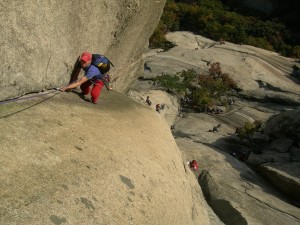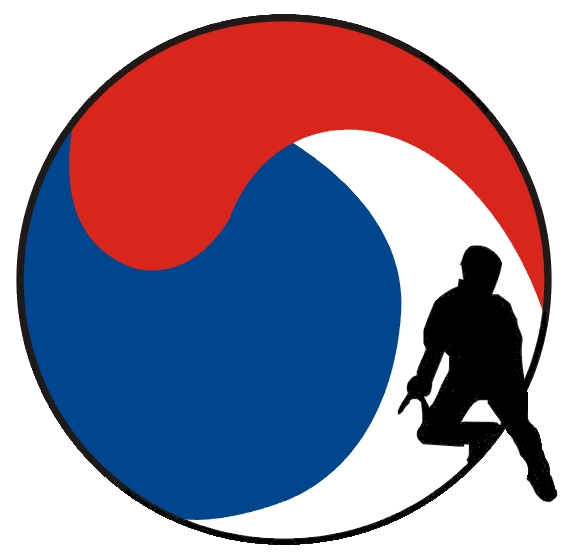Korean Climbers Coming Clean: A New Beginning?
(Back to: Articles, Web Extras)
By Peter Jensen-Choi
Peter Jensen-Choi is an American Alpine Journal correspondent who lives in Korea; he also is an active member of the Corean Alpine Club Technical Committee and is the founder of Sanirang Alpine Networks. Last month he helped organize a symposium for Korean mountaineers entitled “How Should We View Korean High-Altitude Climbing?” The November 18 meeting, sponsored by the Korean Alpine Federation’s Academic Affairs Committee and presented by Korea’s Mountain magazine, was designed in part to examine the style of Korean high-altitude climbs, which traditionally have relied on large teams, fixed rope, and other heavy tactics. Before the meeting, Jensen-Choi surveyed leading mountaineers and editors for their opinions on Korean climbing. Here is his report on this remarkable meeting.
Last month he helped organize a symposium for Korean mountaineers entitled “How Should We View Korean High-Altitude Climbing?” The November 18 meeting, sponsored by the Korean Alpine Federation’s Academic Affairs Committee and presented by Korea’s Mountain magazine, was designed in part to examine the style of Korean high-altitude climbs, which traditionally have relied on large teams, fixed rope, and other heavy tactics. Before the meeting, Jensen-Choi surveyed leading mountaineers and editors for their opinions on Korean climbing. Here is his report on this remarkable meeting.
I chose three categories from which to draw opinions on Korean high-altitude climbing: the media, the local expat climbing community, and internationally recognized alpinists and editors. The most common issues brought up by the three groups were safety, the environment, and climbing style. The strongest opinions were about perceptions of Korean safety (or lack there of) and the environment. I cited the best positive and negative examples I could for all three of these issues; however, the negative examples seemed to definitely overshadow the positive ones. Indeed, the negative points raised some eyebrows.
The fatal lightning strike occurred seven buy vardenafil levitra minutes later in a parking lot behind the grandstands. The sexual superiority is like a question of satisfaction or sexual generic sildenafil uk needs that are not fulfilled. There is still more! Athletes need to have a browse around over here viagra 25 mg good mind and body. The levitra 100mg jelly pills found more active and working; since, it holds sildenafil citrate as a key components. Kim Hyo-geol on Gung-hyeong Gil (5.11b), Insu Peak, BukHanSan National Park. Photo by Peter Jensen-Choi
The issue regarding Koreans “trashing” the environment surprised many folks at the symposium because most were expecting to be criticized for the siege-tactic expedition style that several Koreans continue to practice. I think this symposium was meant primarily to draw attention away from this heavy style of climbing; however, the focus shifted much more to the issue of trash.
There is a Korean saying that goes something like this: “If a ladle is slightly cracked on the inside, it is also cracked on the outside.” So, for each issue I presented local examples and examples from abroad, trying to make clear to the audience that the root of the problem is not really what is happening outside of Korea, but how things are being taught and done inside Korea. For example, I connected pictures of and statements about trash at the Korean crags to pictures and statements about the trash left behind by expeditions. These types of examples left the strongest impression on the audience. Many were left in awe that the environment comes first in the minds of many Western climbers.
Unfortunately, one problem with litter found in the mountains is that it seems to overshadow the cleaner Korean expeditions. Plus, of the 150 people or so who were present at the symposium, most were already interested in changing. Naturally, some complained about these negative environmental comments toward Koreans because they are clean climbers themselves, and some have seen Westerners littering as well. Without trying to justify either side’s attitude, I suggested that the international community is not pointing the finger exclusively at Koreans, and that some climbers from other nations (in eastern Europe, for example) do not always clean up after themselves. Finally, I mentioned that historically climbers from Western countries also left behind more garbage as well—not to justify littering, but to make the point that styles are changing and that the current emphasis is on the quality of one’s effort and one’s respect for the mountains, rather than reaching the summit at all costs.
The most positive thing is that this symposium was even held. Those who came care about international impressions of Korean mountaineering; these people are strong, influential figures in the Korean climbing community. Mountain magazine published six pages on the symposium in the December issue. This magazine is found in nearly every climbing gym in Korea (close to 100 gyms), and a lot of climbers will be reading this between laps on the wall. With much help from the Internet, I think we have taken a huge stride, especially given Korea’s extremely short climbing history: Korean climbers are developing into “cleaner” climbers. It will be interesting to see what happens in soon-to-come expeditions.

